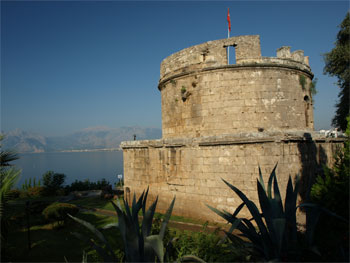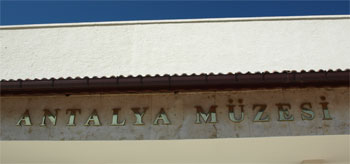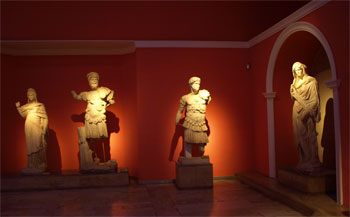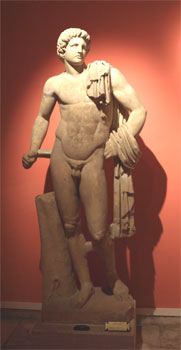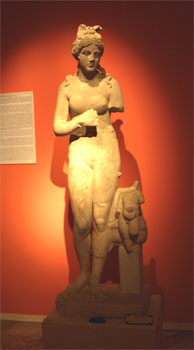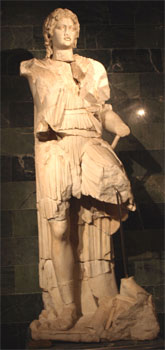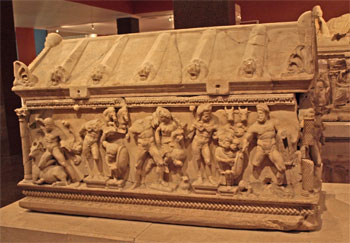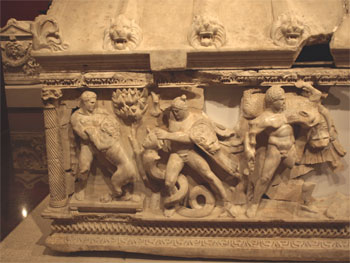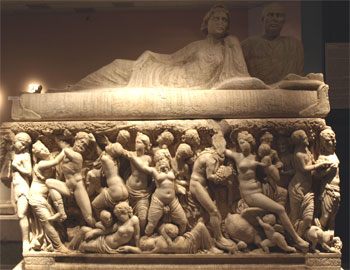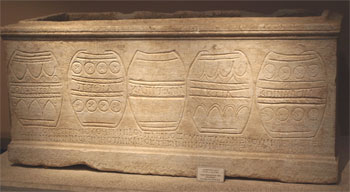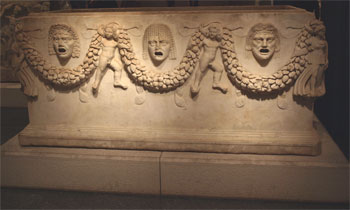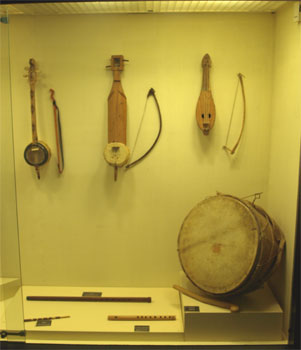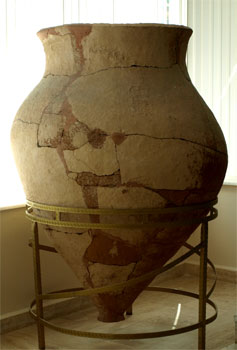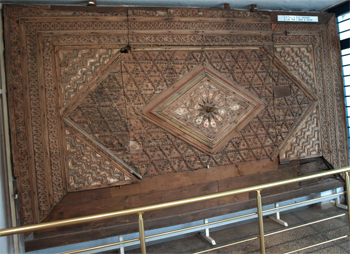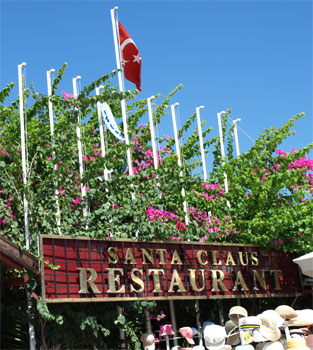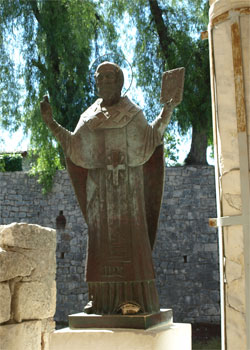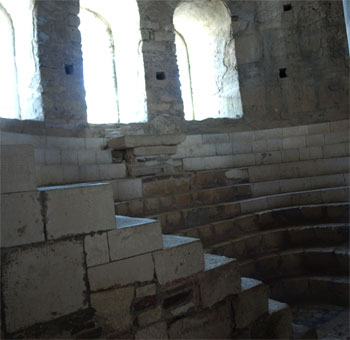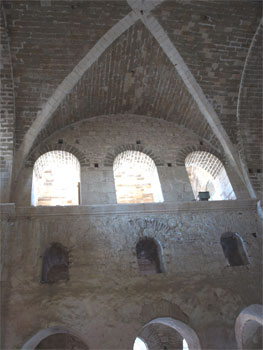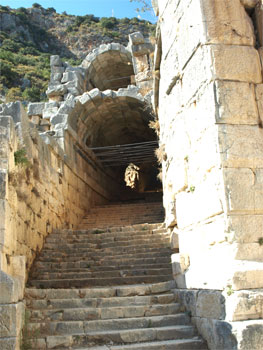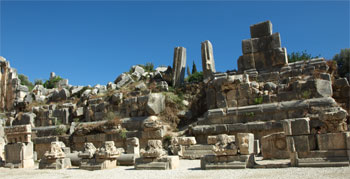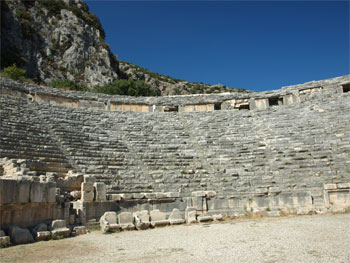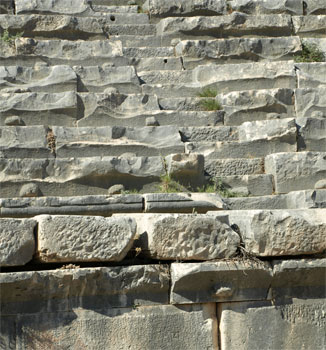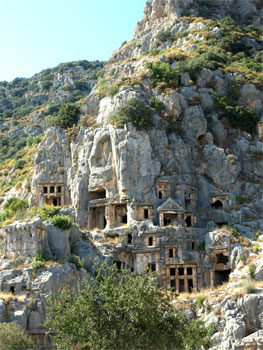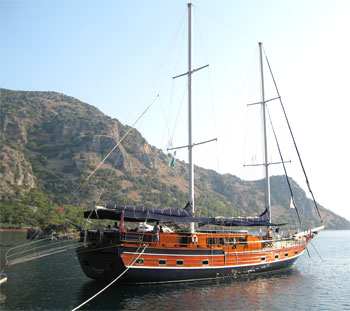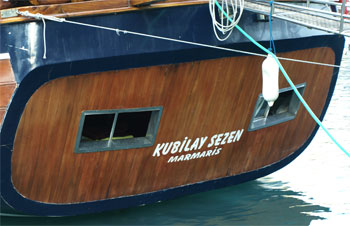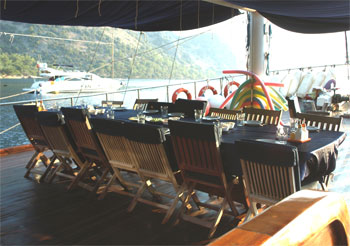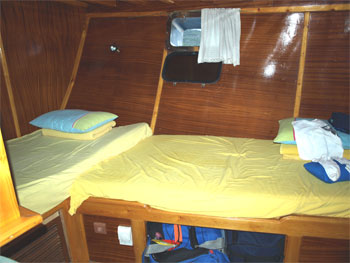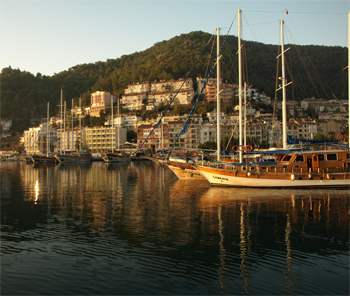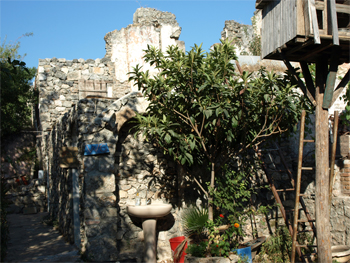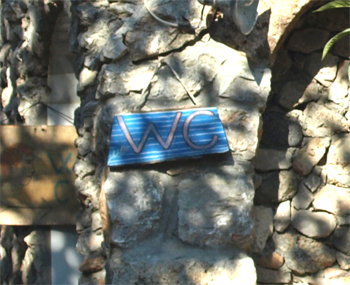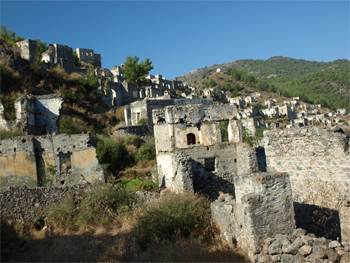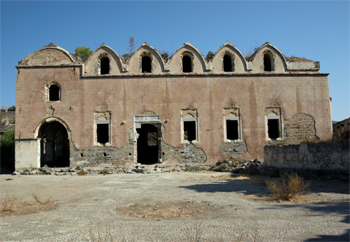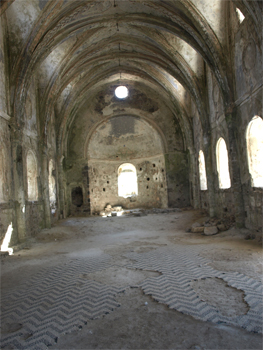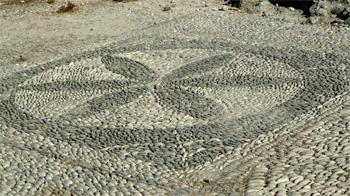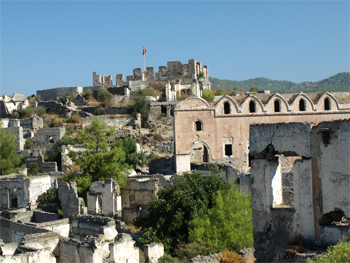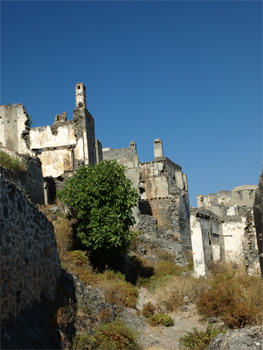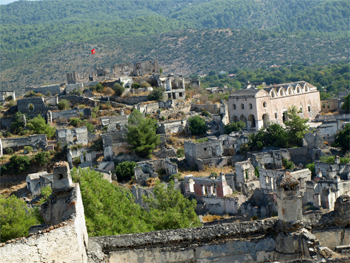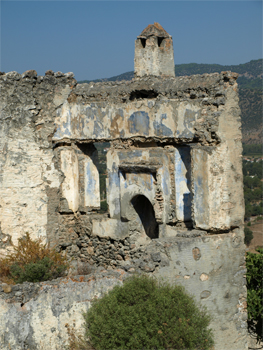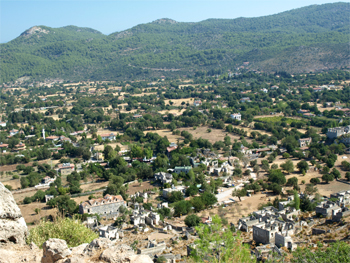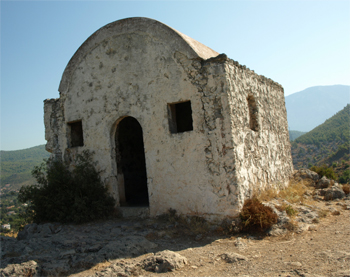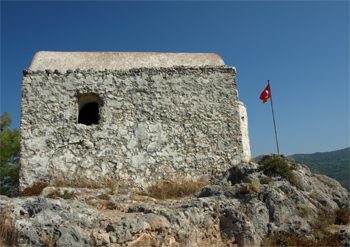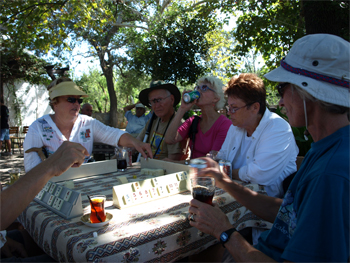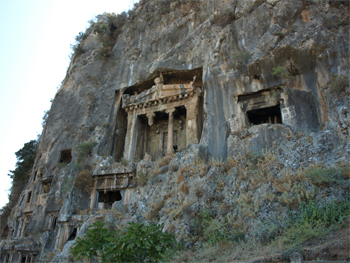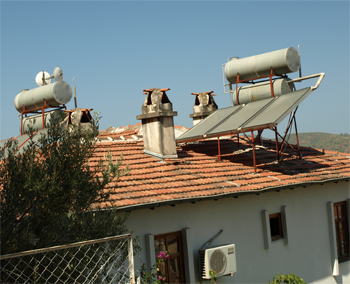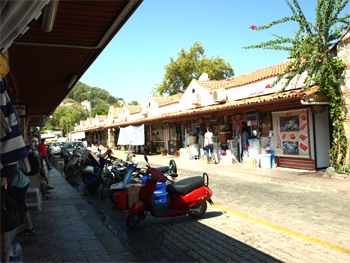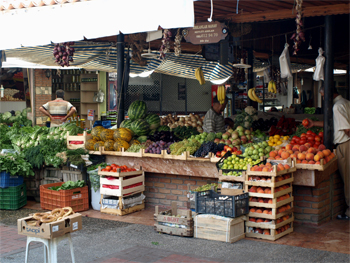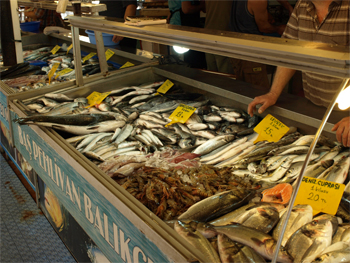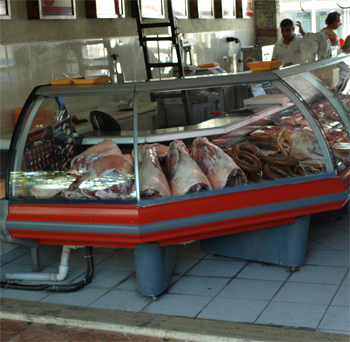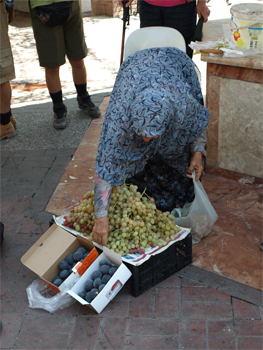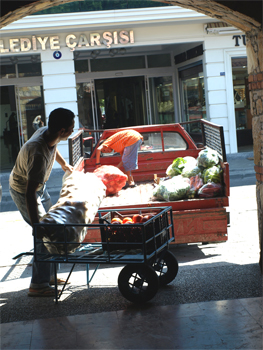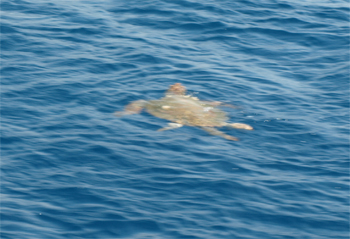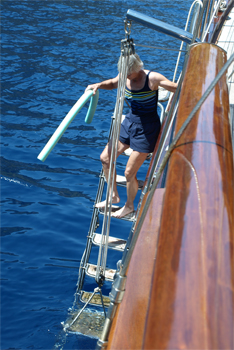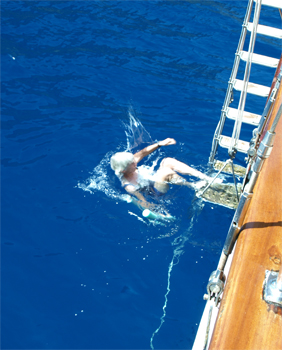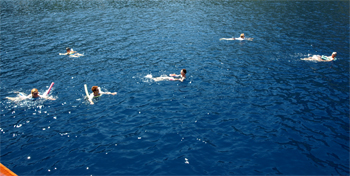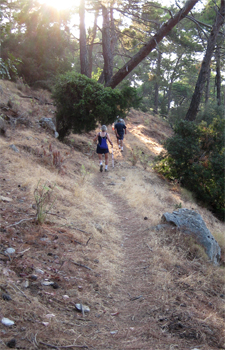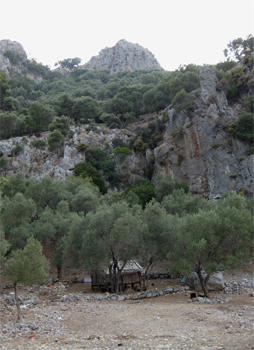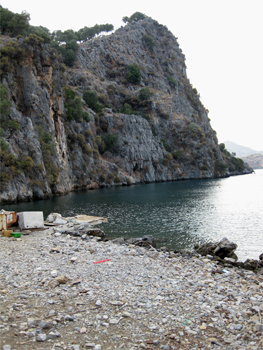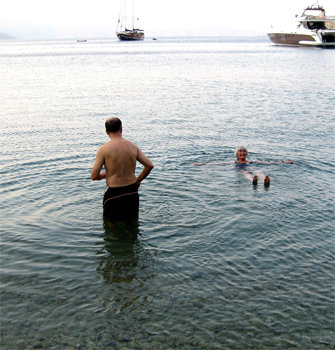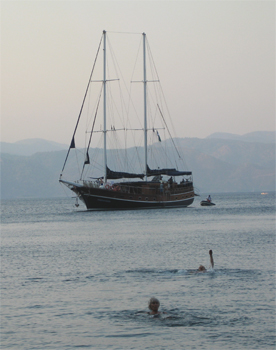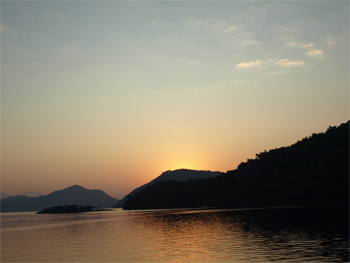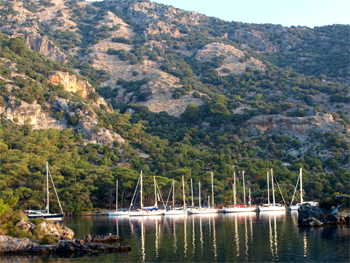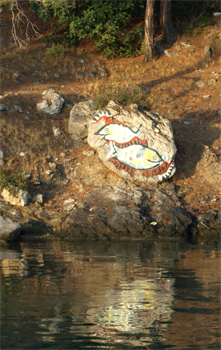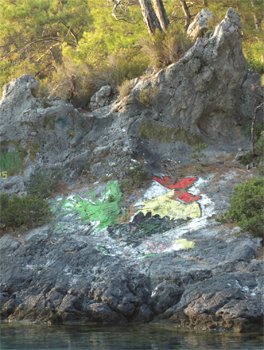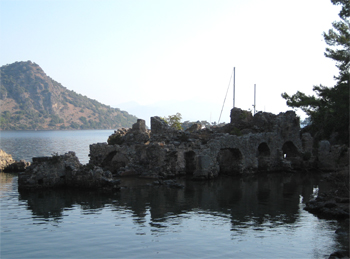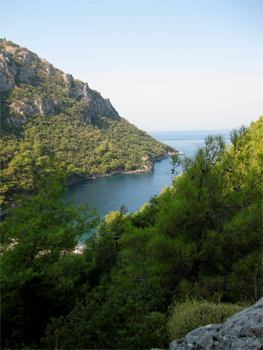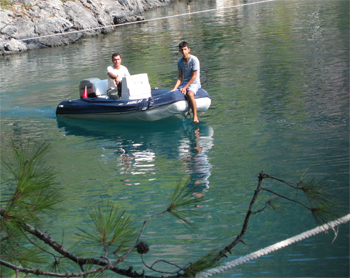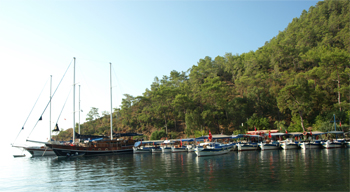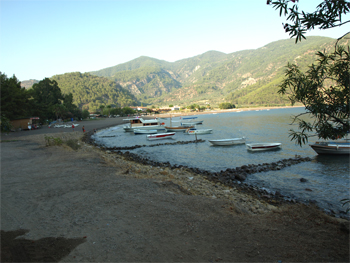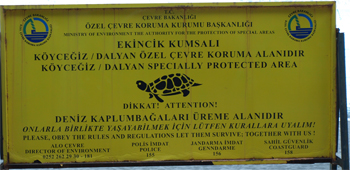Friday - 9/4 – Antalya to Fethiye and our gulet boat
This morning we walked through town and along the park beside the sea. Our bus had collected our luggage and picked us up for a short ride to the Antalya Museum. The artifacts from many of the Turkish digs are on display here. The exhibits began with fossils and items found in graves from 4000 years ago. There were amazing pots and statues. In the Roman period 1 BC to 4 AD people were buried with things needed in the after-life so there were rings and jewelry and items used in their trade. Another room housed the statues found at Perge. Some were in almost perfect condition and others were recreated like putting a jigsaw puzzle together. Another room had sarcophagi of very elaborately carved marble. These were found under mounds of dirt 20 to 60 feet deep. I also enjoyed the display of old instruments with flutes made from bone and a large shepherd’s flute in a woven bag. This is a terrific museum!
Lighthouse overlooking Antalya harbor
|
(Link to further information about the Antalya Museum - use the back arrow key to return here.) |
Statues from Perge |
Apollo
|
Aphrodite
|
Zeus |
Alexander the Great
|
Sarcophagus |
Detail on Sarcophagus
|
Sarcophagus |
Sarcophagus |
Sarcophagus
|
Musical Instruments
|
Musical Instruments |
Burial Urn
|
Ceiling from house in Antalya - carved wood |
We drove west through the forest, passed more greenhouses, and along the Aegean seacoast. We stopped for lunch in Demre and ate Turkish cheese pizza and tomato/cucumber/olive salad and cream of chicken soup. Then we walked through St. Nicholas Greek Orthodox Church. This is the saint that Santa Claus is based on.
The areas which appear as solid gray are all greenhouses |
Lunch spot
|
St. Nicholas
|
Church of St. Nicholas |
Church of St. Nicholas
|
Church of St. Nicholas |
We stopped at the Lycian theater (originally Greek with a semi-circular shape in 1 BC and then rebuilt in Roman style – more oval - after an earthquake) and tombs up on the cliff. The theater had a high wall in front of the front seats to keep the spectators safe from animals. They used to have camel fights (they wrestled with their necks) and bear fights in that theater. Link to information on ancient Myra:
|
|
Entrance to Lycian theater
|
Stage area of Lycian theater |
Amphitheater of Lycian theater |
Detail of seats in Lycian theater - old and worn
|
|
The stone Lycian tombs on the cliffs were carved out and the façades were elaborately carved. Individual tombs were closed with a sliding door that could be opened when the next family member died.
| |
Lycian tombs
|
Detail of Lycian tombs |
The Aegean coast here has very few beaches (only one was sand) or harbors. The coast road goes along and around the cliffs, which slope right down into the sea.
A word about our bus, which we have sat on for six hours today: It is brand new and it was designed by/for Japanese. There is no legroom. We each have a double seat to our self so we can sit sideways, thank goodness. The 6’4” man on our tour has to sit in the middle of the backseat and extend his legs down the aisle. The bus is air-conditioned except it shuts off when we go up hill, which we often do quite slowly.
The roads so far have been in excellent shape. They have all been recently chip-sealed.
In 1923 Turkey became an independent republic and adopted its current border. It also got rid of its Arabic alphabet and now all writing is with Latin letters. Since Arabic had 29 letters, three Latin letters have two sounds and a punctuation mark to identify it. The “u” has an umlaut, the “g” with a long mark, and the “i” is with and without a dot. This makes things a lot easier for us.
We arrived at Fethiye, an old harbor town on the Aegean Sea, and embarked on our gulet boat, the Kubilay Sezen, out of Marmaris, for our next four nights.
|
Our Turkish gulet, the Kubilay Sezen |
We stowed our belongings in our tiny cabin in the bow with a small private bath that is actually larger than our last hotel bathroom. We went up to have dinner on deck in the bow. All 15 of us sit around a large table. We had another typical Turkish meal that was delicious. We went to bed shortly after dinner. Our bunks are at right angles to each other and surprisingly comfortable. There is a sheet on the mattress and a pillow and a waffle weave blanket. We could sleep in our rooms of take the blanket and pillow up on deck and sleep on the lounge pads there - until the dew collected and it got damp. We stayed in our room with the porthole and the door open and tried to think cool. Marge says this is the hottest night she has spent since she was 9-years old and sleeping in an un-air conditioned attic bedroom in Minneapolis. The captain turned on the AC for 2 hours and it didn’t make a dent in the heat.
|
|
Table set for 15 |
Our cabin, bunks, and porthole
|
Saturday - 9/5 - on the Kubilay Sezen
Breakfast on deck was hard-boiled eggs, tomatoes and cukes, bread, cheese, and/or museli and yogurt. After breakfast we took a bus up to the abandoned Rum (refers to the Greek Orthodox people living in Turkey) village of Kaya to hike and explore. This village/town was inhabited by Greeks after the Ottoman Empire weakened. They were mostly tanners of leather and makers of shoes to trade over the old trade routes. After WWI when both Greece and Turkey wanted to become independent republics, the treaty of 1923 created a population exchange. The Turks/Muslims from Greece were given land here in Turkey and the Rums, like in Kaya, were sent to the Greek mainland. This exchange created a ghost town at Kaya. We hiked up the hillside and looked at the ruins of houses and churches. Several earthquakes (1955 and 1999) have left the structures in ruins.
When we got back to our boat we left the harbor and headed for a cove where most of us went for a swim. The water is a perfect temperature - not too cold or too hot - and then we rinsed off and had lunch - Shepherd salad, rice, and a string bean and beef dish.
We sailed to another cove and anchored for the night. We tied up to shore with one or two lines off the stern and dropped anchor off the bow. It keeps us from swinging with the current.
For dinner the captain grilled bream (fish, so I got two chicken legs) on a charcoal fire off the side of the boat. The shrimp we purchased at the market were cooked to Adnan’s recipe: crushed garlic in sea salt, ripe tomatoes crushed into a sauce, throw in the shrimp and boil them in their shells (with heads on) for three minutes. The shrimp were delicious!
Sunday - 9/6 - on the Kubilay Sezen
This morning’s breakfast was a Turkish omelet. The eggs are fried sunny side up over sausage slices. A boat came out to our boat and sold us fresh bread. Yesterday one came out selling ice cream from a cooler on his little motorboat. He had Ben & Jerry’s ice cream bars but we learned that Magnum bars are even better!
After breakfast we tendered to shore (about 30 feet) and hiked along the rocky coast over to a Roman bath, thought to have been built by Marc Antony for Cleopatra. The baths are in ruins now and partially under water. Then we hiked up to the top of the ridge of the isthmus and could see water on both sides.
Sunrise over the Aegean
|
Our cove became crowded overnight! |
Rock art on the shore
|
|
Cleopatra's Baths |
View of the cove on the other side of the ridge
|
Coming to get us
|
We moved to another cove to swim and then have lunch. Then we headed off on a three-hour crossing to another peninsula across the Aegean. We were surprised by how rough it was. Had I known I would have taken Dramamine. It was too rough to be able to move from our seats on deck and by the end of the sail we were all covered with salt from the water washing over the sides of the boat. |
| We arrived at the resort beach of Ekincik, had tea, coffee, and cookies and walked from our landing along a black volcanic sand beach. It was not very attractive and we returned to our boat to read and relax until dinner. |
Harbor at Ekincik
|
Beach at Ekincik
|
Turtle protection sign |
The dinner specialties tonight included grilled meatballs with curry powder and peaches and fancy carved melon and watermelon for dessert.
After dinner we watched an hour and 20 minute DVD on Ataturk, the father of the Turkish Republic. It was a well-done documentary and a shame that in the last ten years the Islamic conservatives are undoing some of his reforms involving women’s rights, education, and separation of church and state.
| Return to Top | Return to Itinerary | Return to Dreamcatcher Home Page |
